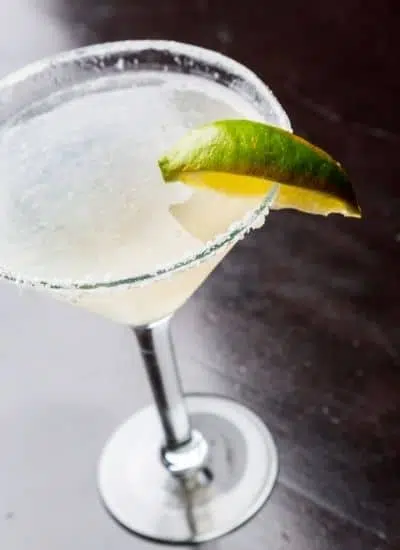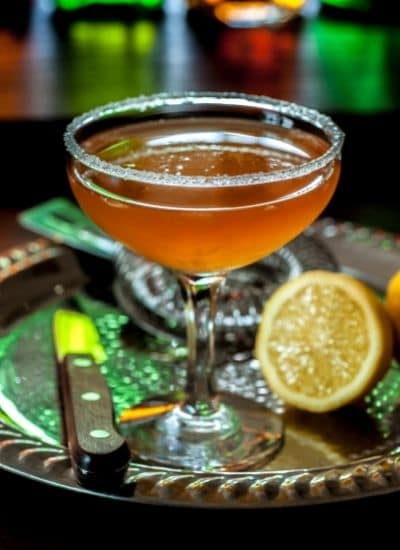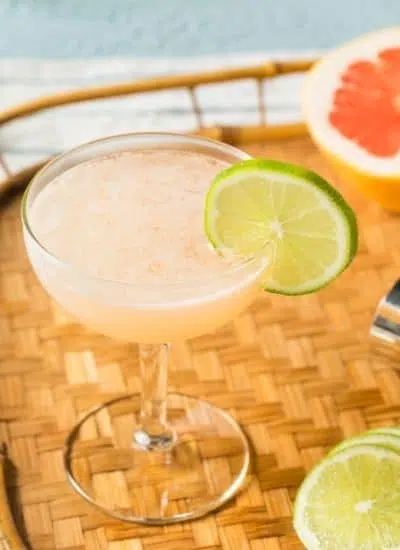The Daisy cocktail once started as a regular cocktail. When Jerry Thomas updated his book The Bar-tender's Guide in 1876, he included the first-ever written recipe for a Daisy cocktail. Nowadays, the Daisy gets regarded as a family of cocktails rather than as a specific recipe.
Just like "mother sauces" in French cuisine, there are different families and categories of drinks in the world of cocktails. Within a family, cocktails share one recipe template. The Daisy template is one of the most popular and famous ones, starring classics like the Margarita and Sidecar cocktail.
The DNA of the Daisy cocktail category is comparable to that of a sour: a base spirit combined with sweetness and acidity. The main difference is in the sweetening part, but let's talk about that in the paragraph about the differences between the Daisy, Sour, and Fizz. Another example would be the Collins cocktail family.
One more difference between the Sour, and a bridge to the Fizz, is the addition of bubbly soda water. This addition brings in lightness, freshness, and complexity due to the carbonic acid. Yet, the soda part is not an essential part of the cocktail and is left out in many recipes.
The Daisy cocktail family
Jerry Thomas published the first Daisy cocktail recipe in 1876. Since then, the Daisy cocktail has been tinkered with a lot throughout the years. Now, the framework or template of every Daisy includes the following elements:
- Spirit
- Citrus juice
- Sweetener (usually liqueur, sometimes mixed with flavored syrup)
- optional: Soda water
In the past, the choice of ice was also a thing with Daisy cocktails. For instance, Jerry Thomas asked for shaved ice while other books wanted cracked or crushed ice.
In the very beginning, the drinks often got sweetened with orange cordial. The more modern take typically uses a liqueur combined with Grenadine. This change happened at some time in the 1900s. So the term "modern" is a bit loose in this case.
The base spirit for a Daisy is not specified, and neither is the glassware. Depending on the recipe, you'll see Daisies poured in Goblets, Old Fashioned glasses, Julep cups, mugs, rocks glasses, or even Highball glasses.
How the Daisy cocktail family is different from the Fizz and Sour
Daisy, Sour, and Fizz - all these four cocktail categories contain a spirit base, citrus juice, and a sweetener. So, what exactly is the difference between all of them. Let's start with the easy part, the differentiation from the fizz cocktail.
The Fizz
Fizz cocktails are closely related to Sour cocktails. They typically contain a spirit base, lemon juice, and simple syrup -Just like a sour. After shaking and pouring these three ingredients into a cocktail glass, chilled and bubbly soda water is added to create a lighter and more refreshing cocktail.
That means soda water is the key difference from a Sour. Does that also mean, Fizz cocktails are Daisy cocktails? No, they're not.
The Sweetener
While all three categories contain a sweetener, the Fizz and Sour get sweetened with simple syrup. The Daisy cocktail family uses something different. Their sweeteners are liqueurs.
While occasionally a bit of flavored or unflavored syrup is added, only very rarely it's solely a flavored syrup like Grenadine with no liqueur at all. Thus, the liqueur part is also the difference between a Daisy with soda water and a Fizz.
One easy way to practically explain the difference between a Sour and a Daisy two is a quick look at the Daiquiri and Margarita. Margarita is the Spanish term for Daisy and consequently part of that cocktail family. Daiquiri, in turn, is a beloved representative of the sour cocktail family. So let's look at the ingredients.
Margarita
- Tequila
- Lime juice
- Triple Sec / Cointreau
Daiquiri
- Rum
- Lime juice
- Simple or rich syrup
Once you understand these templates, it will be easier to determine to which category cocktails belong.
Classic Daisy cocktails
The Margarita is not the only famous Daisy cocktail. I mentioned the Sidecar above, but there are many more. The liqueur part is quite open for interpretation. Therefore, you can find Triple Sec liqueurs, Maraschino, Chartreuse, and many more in Daisy recipes.
The Daisy cocktail family accounts for way too many recipes to list them all in this article. But to give you a better idea of which cocktails are a Daisy here's a short, hand-picked list.

Margarita
The Margarita is a prime example of a Daisy cocktail. A cocktail made from Tequila, fresh lime juice, and sweetened with orange liqueur like Cointreau or Triple Sec.
Originally, it was known as Tequila Daisy. Today, this name refers to a Tequila cocktail closely related to the Margarita but with a few tweaks and additional soda water.

Sidecar
The recipe for a Sidecar is also easily detectable as a Daisy. Based on Cognac, fresh lemon juice, and orange-flavored liqueur (Triple Sec).
Mostly you will see a sugar rim on the glass when ordering a Sidecar cocktail. For some, this is essential, while others substitute simple syrup in the recipe for the sugar rim. That's up to you.

Cosmopolitan
The Cosmopolitain was one of the most ordered cocktails in the 1990s. Starred in the cult series Sex and the City, the cocktail became a huge success and was the most popular cocktail in the US for almost ten years.
The Cosmopolitan is a Vodka-Cranberry made into a cocktail. To make a great Cosmo, beside Vodka and cranberry juice, you need lime juice and Cointreau.

Hemingway Daiquiri
Last but not least, the Hemingway Daiquiri, also called the Papa Doble. This one's particularly interesting as it transforms a classic Sour Daiquiri into a Daisy cocktail.
This sugarless, Hemingway-inspired twist on the classic recipe features Maraschino liqueur and grapefruit juice instead of the traditional sweetener (simple syrup).

